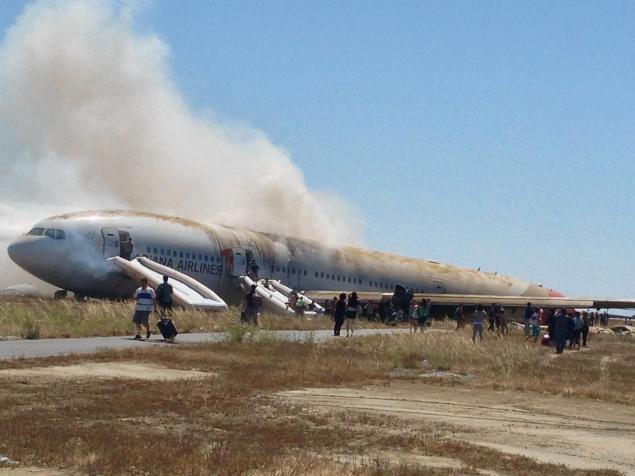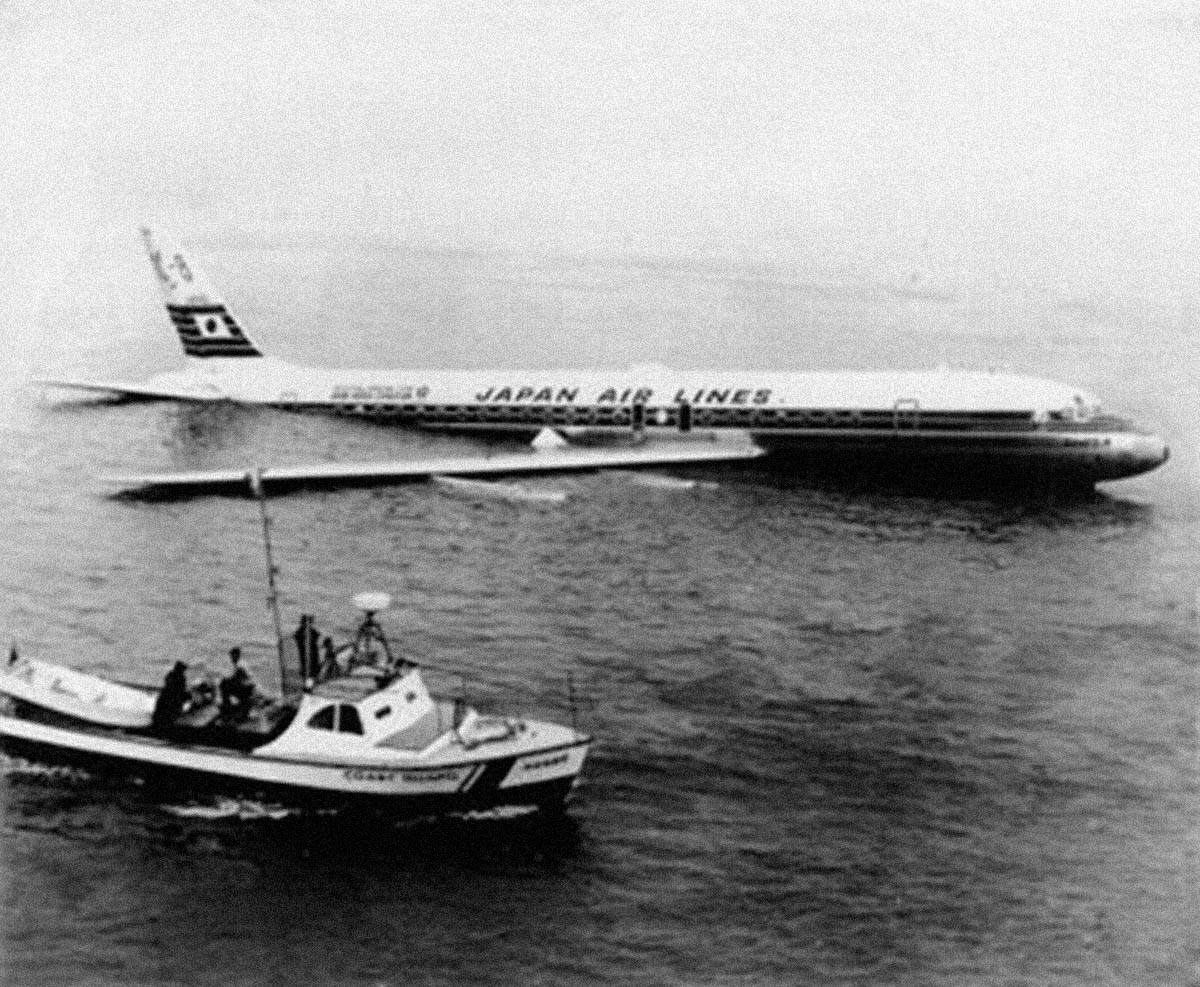As a young Marine Corps student pilot I remember my instructor telling me, “Any fool can fly an airplane and I’m the living proof of that.” His self-deprecating point, of course, was that principles of flight are fairly simple and can be mastered with practice. I have no formal training in aircraft accident investigation, but with 30 years as a Marine Corps and Pan Am pilot here’s what I think happened with Asiana Airlines last week.
Last Saturday, on a clear day, Asiana Airlines Flight 214 crashed into the seawall at San Francisco International Airport with three pilots in the cockpit.
I really like Asiana, but when an aircraft lands short of the runway the pilots are almost always at fault. I didn’t want to believe it. I struggled to find an explanation. I wanted to hear that there was a mechanical or electrical malfunction, but in my heart of hearts I knew that this kind of accident was all about what the pilots did or didn’t do. While the initial reports were still coming in I flashed back to the 2009 Air France 447 flight that plummeted into the Atlantic Ocean from it’s cruising altitude of 35,000 feet. It seems clear to me that the pilots in both cases had forgotten their earliest training on how to fly an airplane.
How could these accidents happen? How could three experienced Asiana “pilots” let an airplane fly itself and its 300 passengers into the SFO seawall? How could three experienced Air France pilots fail to identify a stall situation and allow their aircraft to fall 35,000’ into the ocean when there was ample evidence of what was happening and time to take corrective action? The explanation is one that is hard to accept. These pilots displayed an embarrassing ignorance of flight principles, lack of training, and manual, hands on flying skills.
We should be clear about one thing; these jumbo, long haul airplanes, flown by flag carrier airlines on international routes are the purview of senior pilots. They are the most sought after flying jobs. It takes seniority to get them and they pay more than the slots on smaller aircraft. All of the pilots involved in these two accidents were high time aviators, even though one or more of them may have been new to the particular model of airplane. Nevertheless, an airplane is an airplane and flying principles are transferable. No commercial pilot is released from training and given command authority without training on the aircraft model, passing a check ride in a simulator and undergoing a minimum number of hours of supervised line experience. In fact, the pilot “flying” the Asiana jet was in that supervised stage of training at the time of the accident. The Check Pilot was in the cockpit monitoring the approach.
Aircraft are complicated engineering achievements but flying them today is not much different that it was 75 years ago. Automation has brought autopilots, auto throttles, flight directors, Category II and III auto-land systems, stall and ground proximity warning systems, and computerized displays, but every airplane including the Boeing 777ER (Asiana) and the Airbus 330-203 (Air France) has an altimeter, an airspeed indicator, a rate of climb indicator, an artificial horizon AND the aforementioned stall warning system, and every pilot learns how to fly and to evaluate an aircraft’s attitude and performance using these instruments (without automation).
One of the first things a pilot in training learns is what happens when an aircraft stalls. He or she also learns how to identify a stall, how to prevent it, and what steps to take if, for some reason, it happens anyway. An aircraft stalls because there is not enough air flowing over the wings to provide the lift that keeps it in the air. In the simplest terms when an aircraft stalls it stops flying and starts falling. That is exactly what happened in the Asiana and Air France accidents, and in both cases the pilots failed to identify the stall or correct appropriately.
The details of these flight failures are different and there were unforeseen factors affecting both but in both cases the pilots failed to identify the problem and take corrective action in a timely manner. Senior pilots don’t get paid those big bucks for sitting on their butts at 35,000’ for 11 hours. They get paid for addressing unusual or emergency situations, identifying the problem, making good decisions, and taking corrective action. I personally disliked flying across the ocean because those long flights had only one takeoff and landing. I opted to be based in Berlin and fly within Europe where we made six takeoffs and landing every day. It’s not easy to stay proficient when you only see six or seven landings a month and share them with a co-pilot.
On the Air France flight from Rio to Paris in 2009 Flight #447 lost its airspeed indication and the autopilot disengaged as a result. That’s what is supposed to happen when the airspeed indicator fails. It’s alarming and infrequent but it can be identified and dealt with. The airspeed indicator gets its inputs from a pitot system that measures airflow and pressure differential that is correlated and sent to the airspeed indicator. That pitot device is heated to prevent freezing but it is not uncommon for the heater to fail with a corresponding failure of the airspeed indicator. It’s an adrenaline pumping situation, but all pilots in training are schooled on this emergency there are recommended procedures for dealing with it – keep the wings level, stabilize the power, and maintain altitude until the situation can be fully evaluated. It can take a couple of minutes to figure it out, but it should be part of every pilot’s training. In no case should the pilot rely solely on one instrument like the airspeed indicator. The Air France pilots did just that and for some reason, still unknown, pulled back on the stick and started a climb that led to a stall. Then exacerbating the situation he continued to pull back on the stick which maintained the stall condition all the way to the water. 228 people died needlessly.
The Asiana crew’s malfeasance was even more egregious although there were fewer fatalities. Even when an aircraft is automated the pilot’s role is to monitor all conditions in and out of the cockpit. The basic skill involved is called scanning. It means that the pilot’s eyes are always scanning the instruments for indications of anything out of the ordinary. This is true at all altitudes but critical on takeoff and landing. The unaccounted for factor last Saturday was that the glide slope of the Instrument Landing System (ILS) was not operating, so the aircraft could not make an automated (coupled) approach. This is not uncommon and it was a beautiful clear day. All the aircraft approaching Runway 28 were making visual approaches but had centerline guidance and radar monitoring. Other aids were also available to help the pilots. Published approach charts, carried by the pilots, provided a profile of the approach with recommended altitudes at specific distances from the runway. For some unexplained reason the Asiana pilots were negligent and failed to monitor either airspeed (40 knots below the target) or altitude (significantly below the recommended profile) on final approach and stalled out just before hitting the seawall 1000’ short of the runway threshold. The NTSB investigators reported that the crew identified their dangerous situation 9 seconds before impact and called for a “go around” but it was too late. The throttles, set to auto-throttle mode, were at idle and unable to spool up in time. Like the Air France crew, the pilot in command’s response was to pull back on the controls when he was already too low and too slow, which aggravated the stall condition. Three people died. Both of these accidents were 100% preventable.
Automation has made flying safer, smoother, and more efficient. GPS has made navigation easy and If the airport is so equipped it has made it possible to land an airplane in zero visibility conditions. But, it takes experienced eyes to monitor what is happening and recognize deviations from normal. The 777ER and the Airbus 330-203 are remarkable aircraft. As the crash at SFO demonstrated, survival is possible in some situations because of improved structural engineering, safer less flammable materials and the professionalism and training of the cabin crew.
I wrote a blog in April celebrating the professionalism at Asiana. I have crossed the Pacific six times in the last two years on Asiana. Each time the experience was above average for airline travel in this age. I was stunned when I watched the SFO accident happening live on CNN.
There will be a lot of speculation about why these two accidents happened. When I was hired at Pan Am most of pilots were trained in the military and had high levels of quality flight experience. That is not true today and certainly not true at foreign airlines. There is speculation that cultural factors may have played a role in the Asiana crash. Was there reluctance on the part of the co-pilot or check pilot to correct the pilot who was flying the airplane? Was face saving a factor? I don’t know the answer to these questions.
Those with long memories might remember a similar but non-fatal accident in 1968 when a Japan Airlines DC-8 made an unintentional water landing short of the same runway (28L) in San Francisco. It was another case of pilot inattention and basic cockpit scanning. The JAL Captain Kohei Asoh took full responsibility for the mishap, responding to the NTSB investigator’s question about how he managed to land 2 ½ miles short of the runway by saying “As you Americans say, I fucked up.” His honesty and acceptance of responsibility has since been dubbed the Asoh Defense. Captain Asoh was demoted to First Officer and after additional training resumed flying for JAL until his retirement.
Much has changed since Captain Asoh pancaked in SF Bay. Aircraft systems are more complex and flight regimes more automated. Not only does the initial and recurrent training of pilots need to focus on the new technologies and automation but these accidents remind us that basic flying skills like cockpit instrument scanning, cross-checking, cockpit communication, and stall recovery procedures need to be refreshed. The stall warning in the Air France 447 accident went off 75 times before the plane hit the water. The pilots’ response to that warning should have been automatic – lower the nose and add power to regain flying speed.
In the end, when there is a problem, training is the key to its solution. The problem may surprise us in the moment, but the solution should be readily available in the memory and experience bank from its rehearsal in simulator training situations. We are all human and imperfect. We all make mistakes, but these accidents remind us that there are ways to prevent them from happening again. I believe the changes will be implemented. The airlines are all on heightened alert at the moment. I hope they don’t let the moment slip away.

































